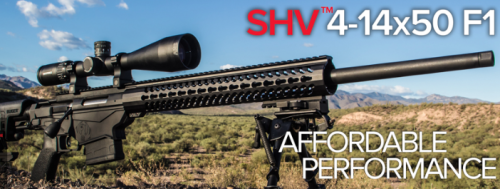
This year at SHOT Show Nightforce announced the new SHV 4-14×50 F1 rifle scope. The SHV stands for Shooter, Hunter, and Varminter, and this is a first focal plane scope.
Nightforce is one of the most respected rifle optics companies in the world. They may not have the tenure of Leupold, Schmidt & Bender, Swarovski, and the likes, but their absolute dedication to high quality glass has garnered them a well-earned high reputation for rifle scopes.

Nightforce SHV 4-14×50 F1 Features
The Nightforce SHV series rifle scopes have won awards from Outdoor Life for their incredible features, and have answered a demand from more traditional shooters who want Nightforce quality at a more affordable price. Don’t be fooled, the SHV series is no “basic” or “bargain” rifle scope. The SHV 4-14×50 F1 scope is an amazing product that packs a serious punch of features that will more than satisfy most shooters. Nightforce did all that while keeping the price tag within reach of many shooters. Not cheap … but reachable if you’re serious!
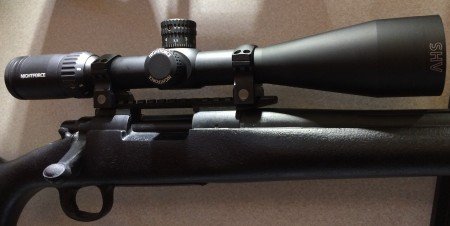
The SHV 4-14×50 F1 has traditional lines, but with the extra-large objective lens. A 50mm (59mm outside diameter) objective lens brings in so much light, and opens up the visual image of the target so nicely for the shooter. I would have expected a 40mm objective lens, but Nightforce really did the shooter well with that feature alone. In addition, the eye lens is an amazing 40mm (43.6 mm outside diameter). Again, this brings the shooter’s eye to target quicker and with more light to view the target with.
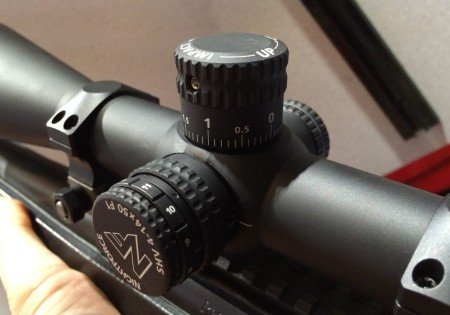
The magnification range is very nice. Though many traditional hunting scopes go down to 3x power, they also typically stop at 9x or maybe 10x. The SHV 4-14×50 F1 range of 4-14 magnification really opens up tough or longer shots for the shooter. Most closer shots can still be easily handled at 4x magnification.
The turrets are exposed (as they should be in my opinion) making any adjustments for elevation or windage easy and able to be done while still looking through glass. I understand covers, and the protection they offer, but I feel a serious rifle scope should have open turrets sturdy enough to handle the elements.
The SHV 4-14×50 F1 scope comes with the shooter’s choice of MOAR (Minute-of-Angle Reticle), or the MIL-R (Mil-Radian) reticle. Either choice gives the shooter a unique view with advantageous markings.
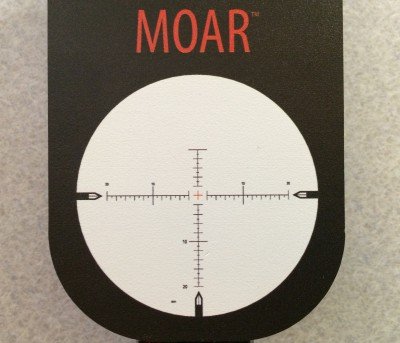
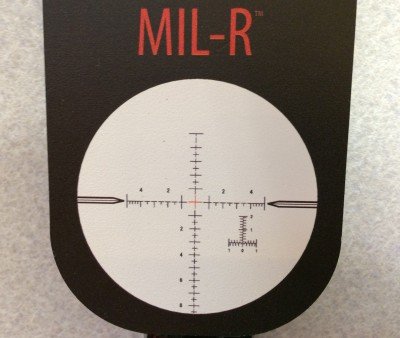
The SHV 4-14×50 rifle scope comes with standard illuminated reticles in both options, making low light shooting not only practical but enhanced as well.
Nightforce SHV 4-14×50 F1 Specifications
- Focal Plane: First
- Objective Diameter: 59mm
- Exit Pupil Diamter: 4x = 10.8mm; 14x = 3.3mm
- Eyepiece Diameter: 43.6mm
- Field of View (FOV): 4x = 25.1 feet; @ 100 yards = 7.4 feet
- Eye Relief: 2.75″ to 3.15″
- Internal Adjustment Range: Elevation = 90 MOA; Windage = 70 MOA
- Adjustments: 0.25 MOA per click
- Parallax Adjustment: 25 yards to infinity
- Tube Diameter: 30mm
- Overall Length: 14.8 inches
- Weight: 30.o ounces
- Mounting Length: 6.1 inches
- Available Reticles: MOAR and MIL-R
- Illumination: Standard
- Elevation Feature: ZeroSet
- MSRP: $1290.00.
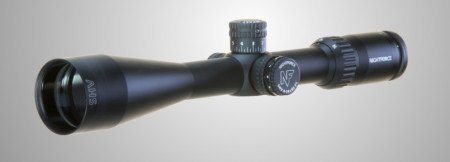
First Focal Plane vs. Second Focal Plane
First focal plane scopes magnify the crosshairs in proportion to the magnified target, where second focal plane scopes keep the crosshairs at a constant size while the target is magnified.
The benefits of a first focal plane scope is that the sub tensions and Mil markings remain in constant proportion to the target even as the magnification increases. This means that an experienced shooter can make appropriate range estimations and hold-over points for their target no matter what magnification setting they are on. First focal plane scopes have been around for some time, but they have recently begun a large surge in popularity.
Second Focal Plane scopes keep the crosshairs small, only magnifying the target with increased magnification settings. This is because the focus of magnification is forward of the crosshairs. This format has been popular with many shooters because it does not interfere with their view of the target by enlarging reticle with magnification. The drawback is that any range estimation or holds are based off a set distance, and do not transfer as magnification increases.